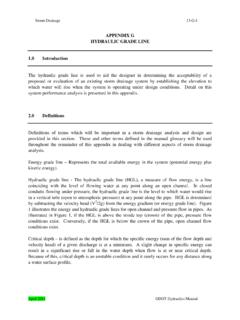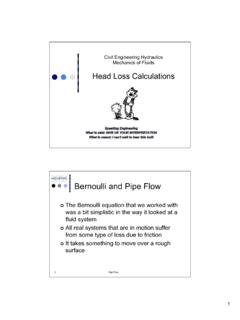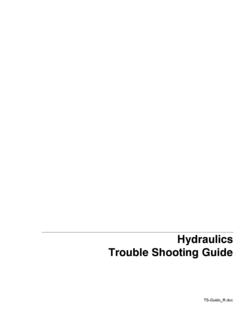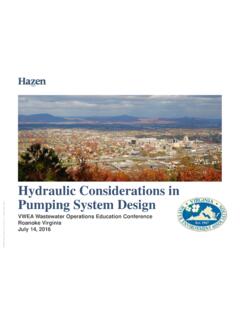Transcription of HY-8 User Manual (v7.5) - Aquaveo
1 HY-8 User Manual ( ) HY-8 Culvert Analysis Program HY-8 User Manual 2 1. Introduction .. 6 Introduction ..6 Getting Started ..7 Differences from DOS HY-8 ..9 Limitations ..10 Vena Contracta ..13 2. Building a Project .. 14 Building a Project ..14 Locate Project ..14 Culvert Crossing Data ..14 Run Analysis ..16 Report Generation ..16 3. Crossing Data .. 17 General Data .. 17 Crossings ..17 Discharge Data ..18 Roadway Data .. 19 Roadway Data ..19 Roadway Profile ..20 Tailwater Data .. 20 Tailwater Data ..20 Channel Shape ..20 Rating Curve ..21 Constant Tailwater Elevation ..22 Irregular Channel .. 22 Irregular Channel ..22 Irregular Channel Error ..24 4. Culvert Data .. 24 Culvert 24 Culvert Data.
2 24 Material ..26 Plastic Pipe Materials ..27 Concrete Open Bottom Arch ..29 HY-8 User Manual 3 South Dakota Concrete Box ..30 Culvert Type ..30 Broken Back Culverts ..33 Inlet Configurations ..36 Inlet Depression ..37 Embedment Depth ..38 Site Data .. 39 Site Data Input Option ..39 Culvert Invert Data ..39 Embankment Toe Data ..40 5. Analysis .. 40 General .. 40 Project Units ..41 Roadway Overtopping ..41 Head Water Computations .. 41 Inlet 41 Inlet Control Computations ..41 Polynomial Generation ..45 Polynomial Coefficients ..45 Outlet Control .. 55 Outlet Control Computations ..55 Exit Loss Options ..60 hydraulic Jump Calculations ..61 Tables and Plots .. 69 Tables and Plots ..69 Crossing Summary.
3 69 Culvert Summary ..70 Water Surface Tapered Inlet ..71 Customized ..72 Controlling Plot Display Options ..72 6. Energy Dissipation .. 74 Energy Dissipators ..74 Scour Hole Geometry .. 76 HY-8 User Manual 4 Internal Energy Dissipators .. 77 Increased Resistance in Box Culverts ..77 Increased Resistance in Circular Culverts ..77 Tumbling Flow in Box Culverts ..78 Tumbling Flow in Circular Culverts ..79 USBR Type IX Baffled Apron ..80 External Dissipators .. 81 Drop Structures .. 81 Drop Structures ..81 Box Inlet Drop Structure ..81 Straight Drop Structure ..83 Stilling Basin .. 85 Stilling Basins ..85 USBR Type III Stilling Basin ..86 USBR Type IV Stilling Basin ..87 Saint Anthony Falls (SAF Stilling Basin).
4 88 Streambed level Structures .. 89 Streambed Level Structures ..89 Colorado State University (CSU) Rigid Boundary Basin ..89 Riprap Basin and Apron ..91 Contra Costa Basin ..92 Hook Basin ..94 USBR Type VI Impact Basin ..97 7. Aquatic Organism Passage .. 98 Aquatic Organism Passage ..98 Stream Simulation .. 98 Stream Simulation ..98 Input Reach Data ..100 Gradation Data ..102 Align and Size Culvert ..103 Results Table ..107 8 Low Flow Hydraulics .. 108 Low Flow Hydraulics Method ..108 Low Flow Hydraulics Interface .. 108 HY-8 User Manual 5 Input Data ..108 Gradation Data ..110 Align and Size Culvert ..111 Results Table ..113 9 Troubleshooting .. 115 Troubleshooting ..115 Registering Libraries ..115 Contacting FHWA.
5 115 HY-8 User Manual 6 1. IntroductionIntroduction HY-8 Versions , , and were developed by Philip L. Thompson and were provided to the Federal Highway Administration (FHWA) for distribution. HY-8 Versions , , and were produced by the Pennsylvania State University in cooperation with FHWA. The HY-8 Versions and earlier versions were sponsored by the Rural Technical Assistance Program (RTAP) of the National Highway Institute under Project 18B administered by the Pennsylvania Department of Transportation. Version (Energy, HYD and Route) was produced by GKY and Associates under contract with FHWA. Christopher Smemoe developed HY-8 at the Environmental Modeling Research Lab at Brigham Young University (BYU) under the direction of Jim Nelson of BYU and with the assistance of Rollin Hotchkiss (BYU) and Philip L.
6 Thompson (Retired from FHWA). The primary purpose of version was to provide Windows-based graphical user interface (GUI) for the same hydraulic calculations performed in version of HY-8. In the course of the development all program culvert modeling functions were translated from Basic to the C++ programming language. Several minor bugs in version were corrected in HY-8 version Versions , , , and of HY-8 were incremental updates in which several new features were included and several bugs were fixed. Besides bug fixes, the following new features were added to HY-8 and : 1. Energy dissipation calculators 2. A new culvert shape/coefficient database 3. The ability to model buried (embedded) culverts 4.
7 The Utah State University exit loss equation was added as an option when computing outlet losses 5. Modeling of plastic pipes 6. Research was conducted relating to sequent depth computations for hydraulic jump computations 7. Several improvements and fixes were made to the HY-8 report generation tools. 8. Section property matrix of 10 points for interpolation was replaced with direct computation of section properties for each discharge. Christopher Smemoe and Eric Jones at Aquaveo (LLC) developed HY-8 with help from Rollin Hotchkiss (BYU) and Philip L. Thompson (Retired from FHWA). The following new features were added to HY-8 : 1. The profile computation code was rewritten to increase program stability and efficiency 2.
8 Capability was added to model hydraulic jumps and their lengths in culverts 3. Capability was added to model broken back culverts and hydraulic jump locations/lengths in broken back culverts 4. Ability to model horizontal and adverse slopes was added 5. Two new culvert types were added to the culvert shape/coefficient database: Concrete open-bottom arch (CON/SPAN) and South Dakota prefabricated reinforced concrete box culverts Christopher Smemoe and Eric Jones at Aquaveo (LLC) developed HY-8 The following new feature was added to HY-8 : 1. Aquatic Organism Passage (AOP) HY-8 User Manual 7 Several graduate students contributed to both the theory and programming efforts of HY-8. Brian Rowley assisted in the development of version and while a graduate student at BYU.
9 Elizabeth Thiele compared several culvert hydraulic computer models in her research and determined several improvements, some of which have just recently been implemented in HY-8 in Culvert Hydraulics: Comparison of Current Computer Models by Elizabeth Anne Thiele (2007). Nathan Lowe studied hydraulic jumps in various closed conduit configurations to make possible comprehensive hydraulic jump calculations in Theoretical Determination of Subcritical Sequent Depths for Complete and Incomplete hydraulic Jumps in Closed Conduits of Any Shape by Nathan John Lowe (2008). Nathan's equations were used to determine locations and lengths of hydraulic jumps in HY-8 HY-8 incorporates stream simulation aquatic organism passage, as described in hydraulic Engineering Circular No.
10 26 (HEC-26) . HY-8 incorporates Low Flow Hydraulics, as described in Fish Passage in Large Culverts with Low Flows . HY-8 automates the design methods described in HDS No. 5, " hydraulic Design of Highway Culverts", FHWA-NHI-12-029 and in HEC , FHWA-NHI-06-086. Version is the last version of the MS-DOS program that was distributed. Hydrologic calculations are available in the Watershed Modeling System (WMS) and in the FHWA hydraulic Toolbox. The software has been structured to be self-contained and this help file functions as the program's user's Manual . This facilitates its use by roadway design squads. However, the knowledgeable hydraulic engineer will also find the software package useful because it contains advanced features.





